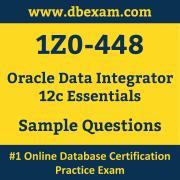01. During ODI installation, which two Fusion Middleware utilities are commonly used to configure the environment?
(Choose two.)
a) Repository Creation Utility (RCU)
b) Upgrade Assistant
c) WebLogic Node Manager
d) OPatch Utility
02. Which key feature differentiates Oracle Data Integrator (ODI) from traditional ETL tools in its data-transformation approach?
a) ODI loads data directly into files instead of databases to avoid network traffic
b) ODI executes transformations in its own proprietary memory engine for faster performance
c) ODI requires an external middleware server to transform data in transit
d) ODI uses the target database engine to perform transformations using ELT processing
03. An organization is evaluating ODI for data integration between an on-premises Oracle Database and a cloud data warehouse. Which benefit best justifies ODI’s selection in this use case?
a) ODI can natively execute parallel ELT processes in heterogeneous environments using database SQL engines
b) ODI requires no connectivity configuration for heterogeneous databases
c) ODI automatically migrates data to the cloud without any agent or network setup
d) ODI runs transformations only on Oracle databases, simplifying administration
04. Which two types of Knowledge Modules (KMs) are used to define data extraction and loading logic?
(Choose two.)
a) SKM – Script Knowledge Module
b) CKM – Check Knowledge Module
c) IKM – Integration Knowledge Module
d) LKM – Loading Knowledge Module
05. You are creating datastores in an ODI model for an Oracle schema. Which component defines the connection between ODI and the schema?
a) Logical schema mapped to a context
b) Physical schema defined in Topology Manager
c) Master repository
d) Work repository
06. When designing an ODI mapping, which element controls where temporary tables are created and transformations are executed?
a) The execution context
b) The staging area location parameter
c) The agent type
d) The work repository
07. A developer observes that an ODI mapping fails due to a constraint violation. Which two troubleshooting steps are recommended?
(Choose two.)
a) Review the session log to identify the failed target table and SQL statement
b) Enable flow control and check knowledge module settings
c) Change the agent heap size to increase performance
d) Disable check constraints in the database schema
08. Which two features in ODI Studio help monitor and prevent run-time errors in mappings?
(Choose two.)
a) Data Flow Simulation Mode
b) Operator Navigator Session Log
c) Auto-generated Constraint Validation (KM option)
d) Model Reverse Engineering Wizard
09. In an ODI–OGG CDC configuration, which component identifies new or changed records for integration processes?
a) ODI Journalizing Model
b) Load Plan Step
c) Knowledge Module Context
d) Work Repository
10. An administrator must choose an ODI Agent type for a large enterprise running on WebLogic Server and requiring high availability and load balancing. Which type should be selected?
a) Standalone Agent
b) Scheduler Agent for ODI Console only
c) Colocated Agent in ODI Studio
d) Java EE Agent (deployed on WebLogic)
 The Oracle Data Integrator Essentials (1Z0-448) Sample Question Set is designed to help you prepare for the Oracle Data Integrator 12c Certified Implementation Specialist certification exam. To become familiar with the actual Oracle Certification exam environment, we suggest you try our Sample Oracle 1Z0-448 Certification Practice Exam.
The Oracle Data Integrator Essentials (1Z0-448) Sample Question Set is designed to help you prepare for the Oracle Data Integrator 12c Certified Implementation Specialist certification exam. To become familiar with the actual Oracle Certification exam environment, we suggest you try our Sample Oracle 1Z0-448 Certification Practice Exam.